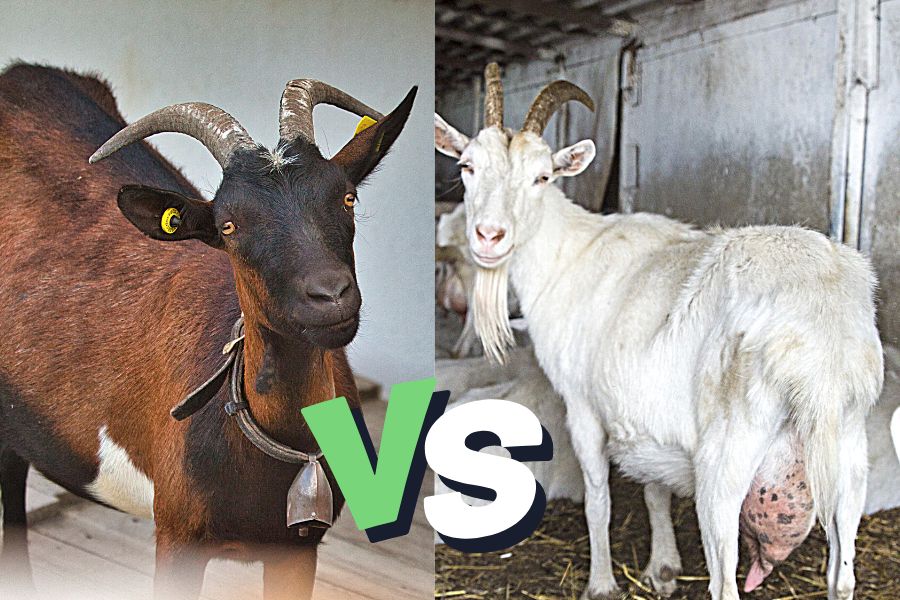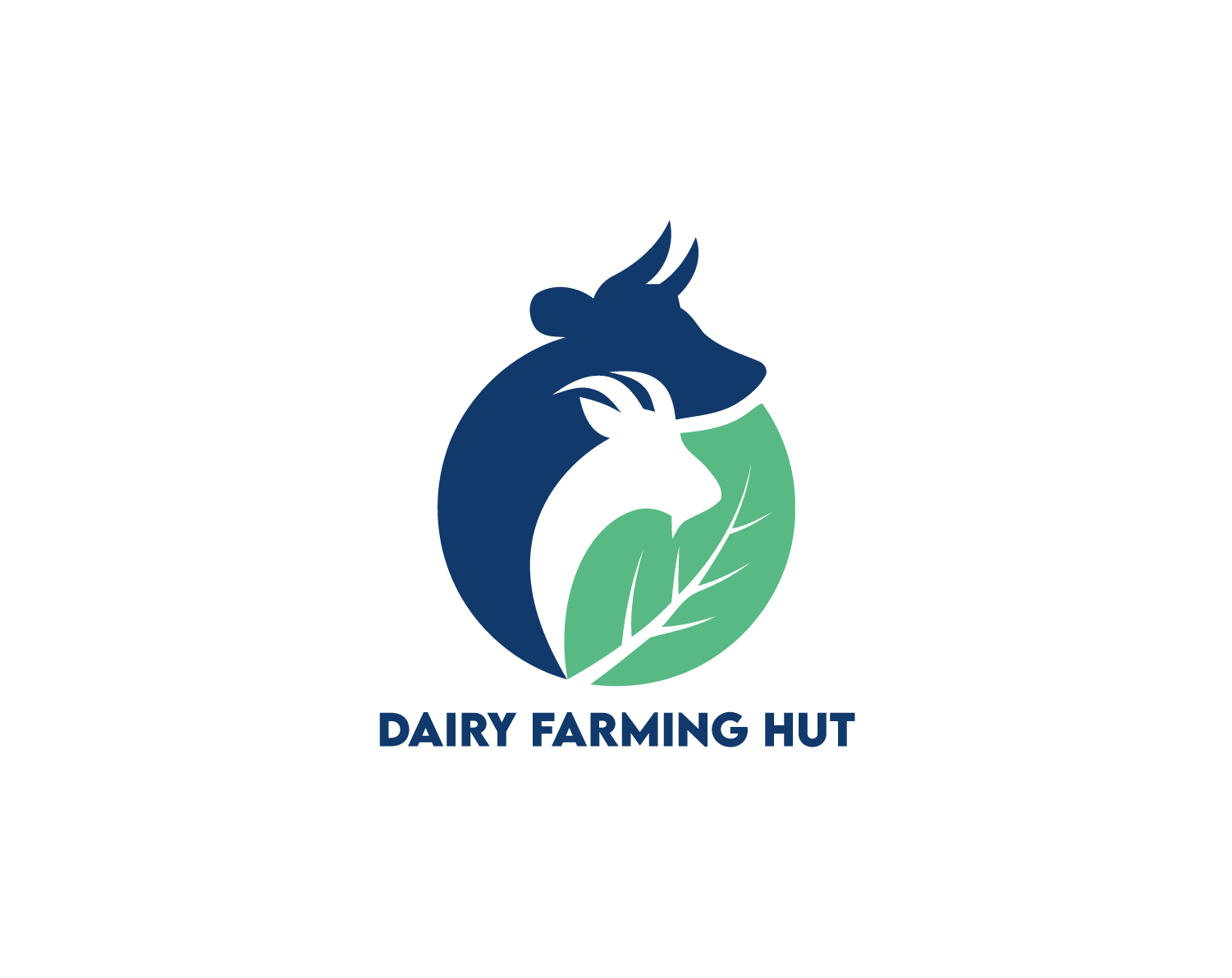Alpine and Saanen goats are excellent milk producers and ideal for small-scale dairy farms or backyard farming. Goats' milk is a suitable alternative to cows' milk for those who are lactose intolerant. Additionally, farming with dairy goats is more environmentally-friendly than husbandry with cows. But what are the key differences between Alpine and Saanen goats?
The key differences between Alpine and Saanen goats are their origin, appearance, and character. Alpine goats originated in France and are smaller than Swiss-origin Saanen goats. Both breeds are top dairy producers but are better suited to certain conditions due to their coloration and temperament.
You should choose your dairy goat wisely, depending on the type of dairy farming you do. Saanens produce more milk, on average, but the fat content of their milk is higher, and they require a lot of shade. Alpines produce almost as much milk as Saanens, but their milk is more nutritionally balanced. Next, let's learn more about the differences between these goat breeds.
The Breed Characteristics Of Alpine And Saanen Goats

While Alpine and Saanen goats are excellent for producing dairy, they differ in coloration, build, and temperament. Additionally, variations exist within each breed due to cross-breeding with goats from other regions.
Breed Variations Of Alpine And Saanen Goats
There are two breed variations of Alpine goats: the purebred or French Alpine and the American Alpine. French Alpines are the purebred variant as they originated from the French Alps. American Alpines, although similar in appearance and temperament, differ slightly from purebreds due to genetic influences from cross-breeding in the United States.
Saanen goats have more sub-breeds. Purebred Saanens originated in Switzerland and have gained popularity in many other countries. Some of the variants of Saanen goats are:
- Banat White in Romania,
- British Saanen,
- Bulgarian White,
- Dutch White Goat,
- French Saanen,
- Improved North Russian White,
- Israeli Saanen,
- Polish Improved White,
- Sable Saanen from New Zealand (a recognized black variant),
- Weisse Deutsche Edelziege (German Improved White), and
- Yugoslav Saanen.
Differences In Coloration And Appearance
Given their coloration, Alpine goats are hardier and can adapt to different climates relatively quickly. On the other hand, Saanens are better suited to cooler temperatures because of their light coloration. Therefore, they ideally need shade or shelter from intense sunlight.
Alpine Goat Coloration
Alpine goats are also called Alpine polychrome due to their multi-colored markings. While they have no set coloration, some coloration is discriminated against. For example, Alpines that are all-white or have Toggenburg patterning are faulted by the American Dairy Goat Association.
American Alpines differ from French Alpines because they have fewer standard markings due to cross-breeding. However, Alpines can have any combination or shading of the following colors: white, gray, fawn, brown, red, black, piebald, or bluff.
Alpine goats have horns and are bearded, and their coats are short to medium in length. Alpine bucks usually have a fringe of longer hair along their spine and a more pronounced beard. This alertly graceful goat breed is the only breed with erect ears. Their ears should be medium-sized and fine-textured.
The typical color patterns of Alpine goats are as follows:
- Cou Blanc ("white neck"): White front quarters, black hindquarters, and gray or black markings on the head.
- Cou Clair ("clear neck"): Front quarters could be saffron, tan, off-white, or gray. Hindquarters are black.
- Cou Noir ("black neck"): Black font quarters, white hind quarters.
- Sundgau: Predominantly black with white markings on the underbody or face.
- Pied: Mottled or spotted.
- Chamoisée (for does) and Chamoise (for bucks): Bay or brown coloration with characteristic markings. Characteristic markings include a black face, feet, legs, dorsal stripe, and sometimes a martingale over the withers to the chest.
- Two-tone Chamoisée: Front quarters have light coloration. Hindquarters are gray or brown. Not to be confused with cou blank or cou clair (black hindquarters).
- Broken Chamoisée: Solid coloration, broken by a band or splash of another color.
If any of the above patterns are broken with white, their coloration pattern should be prefixed with the word "broken," e.g., broken cou blanc or broken cou clair.
Saanen Goat Coloration
Saanen goats are all-white or all-cream, except for the black Sable Saanens in New Zealand. White Saanens occasionally have black spots on their ears, nose, or udders. Their hair is generally fine and short, although some have longer hair on their hindquarters, spine, or both. Spots on the coat of Saanens are considered undesirable.
Not all Saanens are polled, i.e., born with horns. Their ears are usually pointed and erect, and beards are common. A common feature of Saanen goats is "wattles." Wattles are two small external skin appendages with no known function [6]. Usually present on a goat's mid-neck, wattles consist of connective tissue, blood vessels, nerves, and smooth muscle and have a cartilaginous core.
Differences In Size And Build
Alpine goats are medium to large, while Saanens are usually bigger. Below is a table comparing the expected height and weight of each breed:
Header | Alpine Goats | Saanen Goats |
|---|---|---|
Doe Height At Withers | Over 30 inches | About 32 inches |
Doe Weight | At least 135 lbs | At least 141 lbs |
Buck Height At Withers | Over 32 inches | About 37 inches |
Buck Weight | No less than 170 lbs | At least 187 lbs |
Table 1: Expected height and weight of Alpine and Saanen goats
Temperament Differences
Alpine goats are curious and friendly. However, they are also known to be strong-willed and independent. These goats are determined and energetic and will escape over fences or barriers that are not adequately secured. Having said that, they are still good dairy goats for commercial dairy production.
Saanen goats, on the other hand, are more docile and respond better to intensive raising. They can be milked mechanically but do not respond well to extensive management.
Dairy Farming With Goats: Alpine Vs. Saanen
Both Alpine and Saanen goats are bred for their excellent milk production. Saanen goats are the "queens of milk production" among goats, producing a lot of milk with considerably high-fat content. Alpine goats also produce a lot of milk, although the fat content is a little bit less. However, the milk from Alpine goats is more nutrient-rich than Saanen milk.
Alpine and Saanen goats are relatively docile and respond well to machine milking. However, if you are farming these dairy goats on a smaller scale, they should also respond well to hand milking.
Below are some facts regarding the average milk production quantities and the nutritional value of milk produced by Alpine and Saanen goats.
Header | Alpine Goats | Saanen Goats |
|---|---|---|
Fat Content |
|
|
Milk Production Facts And Averages |
|
|
Nutritional Content |
|
|
Table 2: Facts and comparisons for Alpine and Saanen milk production
Fun fact
Did you know that goats' milk is naturally homogenized?
That means that less processing is required before storing or drinking it.
How To Store Goat Milk Effectively?
Goat milk intended for human consumption should be filtered and chilled as soon as it's left the doe's udders. This is to prevent excessive bacterial growth, which occurs at room temperature.
The best temperature at which to store goat milk is 39.9°F. Refrigerated milk has a shelf life of three to four weeks if filtered and chilled immediately. You can extend the shelf life of goat milk by an additional five weeks if you freeze it immediately after filtration.
How To Ensure Optimal Milk Production From Your Dairy Goat?
Regardless of the type of dairy goats you farm, you should ensure the goats are housed in certain conditions to maximize dairy production. If the goats are stressed by changes in external factors, you might find their milk production decreases. You can minimize stress by ensuring the following four housing requirements remain consistent:
- Dry bedding,
- Adequate ventilation,
- Clean water and feeder supply, and
- Minimal disturbance and labor to the goats.
Additional factors that will promote dairy production in your goats include the following:
- Appropriate milking procedures
- Disease control
- Good nutrition
- Proper reproductive management
Husbandry: Alpine Vs. Saanen Goats
Alpine bucks reach sexual maturity at four to five months, while doe kids are sexually mature at five to six months. An Alpine doe should be bred once she is at least 75 to 80 lbs. Gestation is, on average, 150 days, but it can be 145 to 155 days. Alpine goats most commonly give birth to twins, but they can have singles, triplets, quadruplets, or even quintuplets.
Saanens reach sexual maturity between 3 and 12 months. Their breeding season is in the fall, and the does' cycle lasts 17 to 23 days, with estrus lasting between 12 and 48 hours. Gestation is between 148 and 156 days and usually results in twins but sometimes triplets.
When a doe is in estrus (on heat), a buck will smell her and display a behavior called "flehmen." If the doe is in estrus, the buck will extend his neck and curl up his upper lip.
For breeding purposes, a polled buck (a goat naturally born without horns) shouldn't mate with a polled doe, as the resulting offspring might be a sterile male or intersex female. As such, if a polled buck is used for breeding, he should be mated with horned does.
Conclusion
Alpine and Saanen goats are two of the top dairy producers among goat breeds, but they have key differences. Alpine goats originated from the French Alps and have a variety of coloration patterns. Saanen goats are bigger in stature and originate from Switzerland. Saanen goats are known as the "queens of milk production." However, Alpine goats are better suited for commercial dairy farming.
